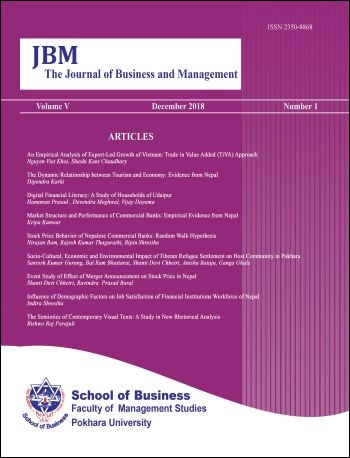An Empirical Analysis of Export-Led Growth of Vietnam: Trade in Value Added (TiVA) Approach
DOI:
https://doi.org/10.3126/jbm.v5i0.27383Keywords:
ARDL, Breakpoint Unit Root, Exports-led Growth, Value Added Export, VietnamAbstract
This paper examines the long-run relationship between domestic value added exports and economic growth of Vietnam using ARDL bounds test of cointegration on annual data covering the period of 1995-2014.The bounds test establishes existence of both short-run and long-run relationship between exports and GDP of Vietnam and shows a substantial contribution of exports in the real GDP (0.73 percent for one percent changes in the domestic value added exports). The exports pattern of Vietnam portrays it following the footsteps of export-led growth model of Mexico, whereby it has turned itself into export production platforms for MNCs by suppressing the wages, rather than developing own indigenous industrial capacity. In such scenario, it seems challenging for Vietnam to sustain its export-led growth which it has achieved so far based on its cheap labour. With the rising living standards, ultimately the comparative advantages of cheap labour force would vanish in the future, which will cause a wave of assembly jobs to flow out of Vietnam. Moreover, two other low-cost countries in the region, Cambodia and Myanmar are likely to rise as close competitors of Vietnam in the low-cost assembly works in the near future. By that time, in case Vietnam fails to enter into higher value added activities, it will drag itself into the ‘middle income trap’. Therefore, the ‘assembly strategy’ shall be bonded with strategy to develop own indigenous industrial capacity, and national technological base. These will help Vietnam to upgrade its activities along value chains in forms of product upgrading, process upgrading, functional upgrading, and sectoral upgrading so that it can switch its role of ‘assembling agent’ to ‘indigenous producer’.
Downloads
Downloads
Published
How to Cite
Issue
Section
License
Copyright © the School of Business. All rights reserved. No part of this volume may be reproduced or utilized in any form or by any means, electronic or mechanical, including photocopying, recording, or by and information storage and retrieval system, without permission in writing from the publisher.




